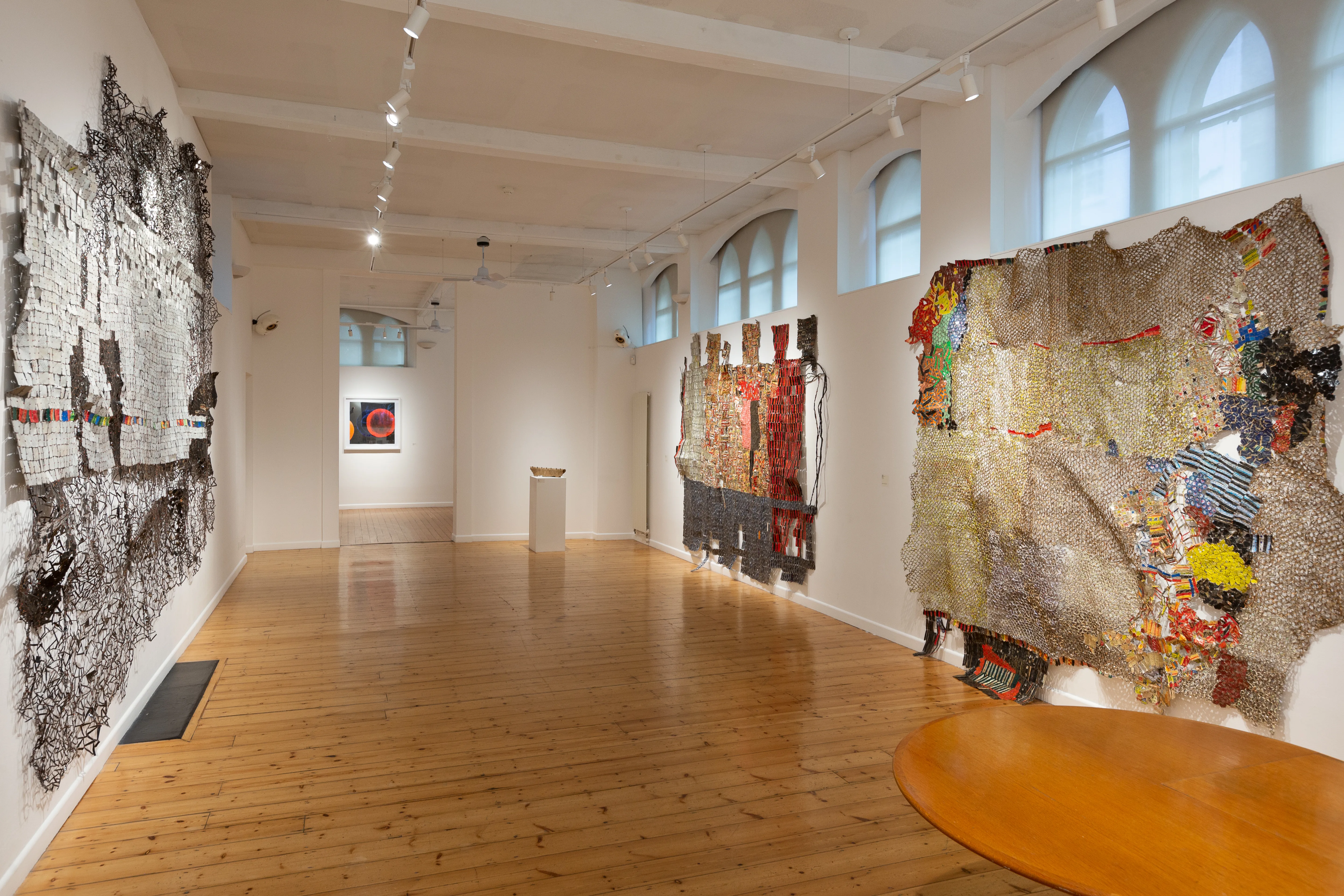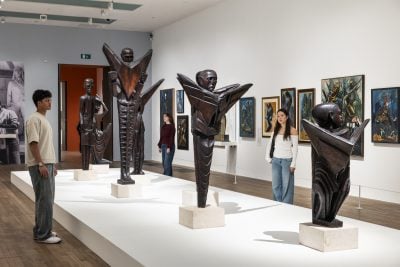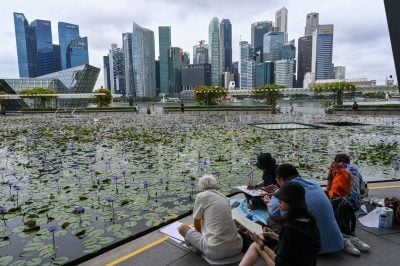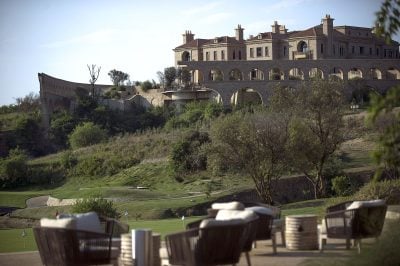Over a career spanning an impressive four decades, the work of renowned Ghanaian sculptor El Anatsui has graced the walls and floors of many prestigious art galleries around the world, from the Metropolitan Museum of Art in New York to the Arab Museum of Modern Art in Doha.
This autumn, two exhibitions showcasing El Anatsui’s innovative work opened in London: in the October Gallery, which specialises in contemporary art; and in the Tate Modern’s famous Turbine Hall. Yet unlike many of the other avant-garde works that grace these galleries, El Anatsui’s masterpieces are no ordinary sculptures, nor paint on canvas.
Just as one man’s trash can be another man’s treasure, El Anatsui uses discarded and recycled items to bring his creative visions to life and give new meaning to jettisoned scrap. His more recent iconic installations, including his sculptures currently on display in the Tate Modern, have gained international fame for being created with aluminium bottle tops joined together by copper wire, among other recycled materials.
Dominating the vast, vertical space of the Tate Modern’s Turbine Hall, which rises 26 metres from ground level, is El Anatsui’s largest work to date; the first act of Behind the Red Moon, which greets visitors as they enter the gallery. A unique exhibition in three acts, Behind the Red Moon invites art lovers to explore the story of thousands of alcohol bottle caps and repurposed objects that have been reshaped and reworked into three acts of abstract art that cascade from the ceiling like a waterfall, dancing and shimmering in the light.
“Behind the Red Moon takes its inspiration from the trans-Atlantic trade, from the histories of the enslaved peoples to the commodities they produced and the economies they helped to create,” El Anatsui tells African Business. “The Turbine Hall is huge and to take advantage of this, I divided the space into three segments, so that a continuous story could be told.”
Across the city in the October Gallery, near Russell Square, is TimeSpace – a solo exhibition of El Anatsui’s works, unveiled during the Frieze London art events week. A representative of the October Gallery says that the TimeSpace exhibition “explores the evolution of El Anatsui’s work, his innovative and experimental approach to tools, processes and materials, and the ways in which he continues to take his work in new directions”.
“The exhibition includes new bottle-top works as well as historical works created in wood, clay and on paper,” says the artist. “Although I don’t consciously think of a theme when I start a work, the bottle-top pieces in this exhibition reflect my response to the material. By allowing the mind to travel freely during the process ideas emerge; for instance, some of the completed works have titles such as Earth Struggling to Grow Roots and Leaves and Clouds Gathering over the City.”

An artist’s response to colonialism
El Anatsui is one of the most renowned artists of his generation in Africa and around the world. His sought-after work sells for millions – which, according to The New Yorker, makes him the first black artist based in Africa to have his works valued at an international price standard. In 2012, his work Prophet sold for $2.3m at Christie’s, 123% over the estimated price.
Yet to better understand El Anatsui’s rise, we must first step back in time into his own history to understand his experimental approach to his works of art and what has shaped the inspiration behind his creation.
El Anatsui was born in 1944 in Anyako, in the Volta Region of Ghana, when it was still a British colony. It would remain so for several more years, under the name of the British Gold Coast, an epithet it had held since 1874, when the British declared the coastal area for themselves.
The Ghanaian independence movement, however, had been growing since before El Anatsui was born, and in 1957 the Gold Coast became the first sub-Saharan colony to become an independent nation, under President Kwame Nkrumah, who had led the fight for independence. El Anatsui grew up in a nation that was truly ahead of its time, as over the next decade 30 other African countries rightfully declared their own independence.
In 1964, when El Anatsui began his artistic studies, many African countries were experiencing a cultural renaissance born from decolonisation, and it is against this backdrop that he began his artistic career.
Cut off from his indigenous culture during his childhood and forced to follow a British art school curriculum, El Anatsui explains in an interview with Art Africa that a visit to the National Cultural Centre in Kumasi to observe local artists working in media ranging from bronze and brass to printed textiles fed his inspiration for exploratory art that did not conform to the limited categories imposed by Western art history.
Over a career spanning more than forty years, El Anatsui has used media including wooden pallets, milk-tin lids, and clay to bring his creative ideas to life. His earlier artwork forms part of the exhibition in TimeSpace, including the wooden wall piece Solemn Crowd at Dawn and clay sculptures from El Anatsui’s Venovize series, both created in the 80s. These are displayed alongside some of his most recent works created this year, including G6 and Royal Slumber, both of which are crafted from thousands of aluminium bottle tops from alcoholic drinks.
“I am interested in old objects, and I find that used items resonate with history,” says the artist. “In Ghana, I discovered craftsman who were making wooden apampa food trays. I would direct them to produce trays for me with adinkra patterns, traditionally used on fabric. This is one example of blending tradition in different way to give it another life and another meaning.
Beauty representing pain
Speaking to The Guardian, El Anatsui states that alcohol, such as rum made in the Americas, was a key commodity used by Europeans in the transatlantic slave trade, to barter in exchange for enslaved African people. As he explains, the drink represented by the bottle cap explicitly links all three continents involved in this horrific enslavement of men, women, and children.
Perhaps more tacitly, the bottle caps, which are seals trapping the liquid inside the bottle, could be read as a grim metaphor for the horrific treatment of the stolen African people themselves, forcibly trapped as slaves and held thousands of miles from their homeland.
Walking through the Behind the Red Moon exhibition in the immense Turbine Hall and looking up at the immense hanging statues created from these shimmering metallic caps, it is difficult to understand how something that is seemingly so beautiful can represent so much generational pain and hurt.
Likewise, several of El Anatsui’s older wall artworks displayed at TimeSpace are crafted from wood that has been torn apart and damaged by a chainsaw, which El Anatsui explains represents how the African continent was partitioned by European powers.
Yet it is precisely El Anatsui’s creation of visual beauty from such unassuming materials that makes his work so breathtaking. By weaving together discarded and jettisoned objects, El Anatsui conveys a whole other meaning within his work, in the abstract language of art that needs no words. From the very first, he took charge of his artistic vision, rejecting any imposed limitations or restrictions placed on his creativity that dictated what art could, or should, be, challenging the preconception that art is something that is only done correctly in the West.
“Continents are linked by peoples’ histories, for good and or bad,” says El Anatsui. “A viewer can experience art as a way of storytelling, and perhaps rediscover identities through a uniquely physical encounter. This can prompt discussions that can change perceptions and perspectives.”
El Anatsui’s influence on the understanding of contemporary sculpture led to his being awarded the Golden Lion in 2015 at the 56th International Art Exhibition of the Biennale di Venezia, in recognition of his lifetime of achievement in the arts, not only recognising his renowned international success, but also his profound influence on subsequent generations of African artists. Earlier this year he was named as one of Time’s Top 100 influential people of 2023 and, at the age of 79, his star just keeps on rising.
El Anatsui’s transcendental art and its enduring impact has ignited conversations, sparked reflections, and he has inspired artists and art lovers alike with his interpretation of what art is, and how it can educate.
His astounding career serves as a testament to the enduring power of his artistic vision and determination which will no doubt inspire the hearts and minds of generations of artists on the continent and around the world to come.
TimeSpace will be displayed at the October Gallery, London until 13 January 2024 (entry free)
Behind the Red Moon will be displayed at the Tate Modern, London until 14 April 2024 (entry free)
Want to continue reading? Subscribe today.
You've read all your free articles for this month! Subscribe now to enjoy full access to our content.
Digital Monthly
£8.00 / month
Receive full unlimited access to our articles, opinions, podcasts and more.
Digital Yearly
£70.00 / year
Our best value offer - save £26 and gain access to all of our digital content for an entire year!

 Sign in with Google
Sign in with Google 



